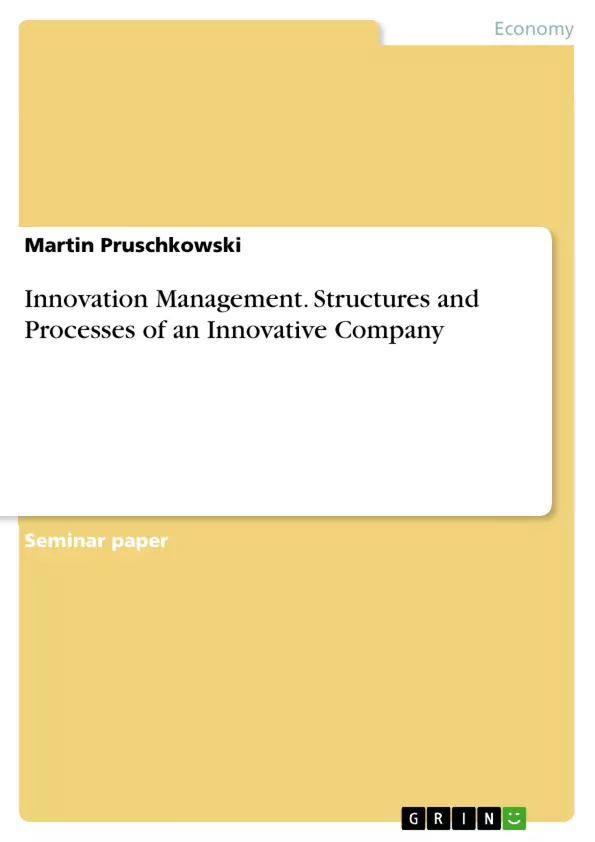Innovations are not a stroke of luck. Most innovations result from a systematic process. Peter Drucker wrote of innovation management as a learnable, controllable and manageable discipline. This statement can be seen that any company in any country, no matter how large, in what industry, international or local can be innovative if it considers and implements certain rules. Innovation management deals with these aspects. The objective of this work is to work out what structures and processes have to exist within a company in order to become and remain an innovative company.
This work is divided into different parts. The first part “Fundamentals of innovation management” introduces the definition of the term innovation and the relationship between ideas and innovations. Furthermore the first part presents briefly the importance of innovation. The second section “Developing an innovation-friendly organization” demonstrates that the innovation activity of the entire company is affected by four individual factors. These four factors the innovation willingness, innovation possibility, innovation capability and the innovation process are closely considered in this part. The last section “Conclusion” will complete and limit the entire work and will give recommendation for further research.
For that work no primary data was gathered, the entire work is based on secondary data as the scope of this assignment does not allow for any explorative approaches, interviews or surveys. The necessary information for the work that were previously scattered published or accessible will be arranged, analyzed and interpreted. The sources of secondary data are gathered form books, magazines and sources in the worldwide-web
Inhaltsverzeichnis (Table of Contents)
- Introduction
- Problem definition
- Research question
- Structure and methodology
- Fundamentals of Innovation Management
- Definition and identification
- Significance of innovations
- Economic significance
- Company significance
- Developing an innovation-friendly organization
- Innovation willingness (want)
- Corporate goals and strategies
- Innovation strategies
- Personnel structure
- Innovation possibility (may)
- Innovation culture
- Innovation structure
- Innovation capability (can)
- Innovation process (do)
- Conclusion
- Summary
- Answering the research question
- Limitation of the research
- Recommendation for further research
Zielsetzung und Themenschwerpunkte (Objectives and Key Themes)
This study aims to analyze the structures and processes involved in fostering innovation within a company. It examines the critical elements of a company's environment and how they influence the need for innovation, highlighting the importance of adaptation and renewal for survival in today's rapidly changing markets.
- The importance of innovation for company survival and competitiveness in a dynamic environment.
- The key factors that enable companies to adapt and innovate, including corporate strategy, innovation culture, and structure.
- The role of innovation processes in driving successful innovation, from idea generation to implementation.
- The significance of organizational change and adaptability in facilitating innovation.
- The impact of innovation management on a company's success and long-term growth.
Zusammenfassung der Kapitel (Chapter Summaries)
The introduction sets the stage by defining the problem of innovation management and outlining the research question. It uses the example of Nokia to illustrate the importance of innovation for company survival and the consequences of failing to adapt to changing market conditions.
Chapter 2 delves into the fundamentals of innovation management, providing a definition and identification of innovation. It then explores the significance of innovations, examining both their economic and company-specific impact.
Chapter 3 focuses on developing an innovation-friendly organization. It explores the key aspects of innovation willingness, including corporate goals, strategies, and personnel structure. The chapter also examines the aspects of innovation possibility, focusing on innovation culture and structure. In addition, it addresses innovation capability and the importance of innovation processes in driving successful innovation.
Schlüsselwörter (Keywords)
This research focuses on innovation management, corporate strategy, innovation culture, organizational structures, innovation processes, organizational change, adaptation, and competitiveness.
- Quote paper
- Master of Business Administration (MBA) Martin Pruschkowski (Author), 2015, Innovation Management. Structures and Processes of an Innovative Company, Munich, GRIN Verlag, https://www.grin.com/document/432964



